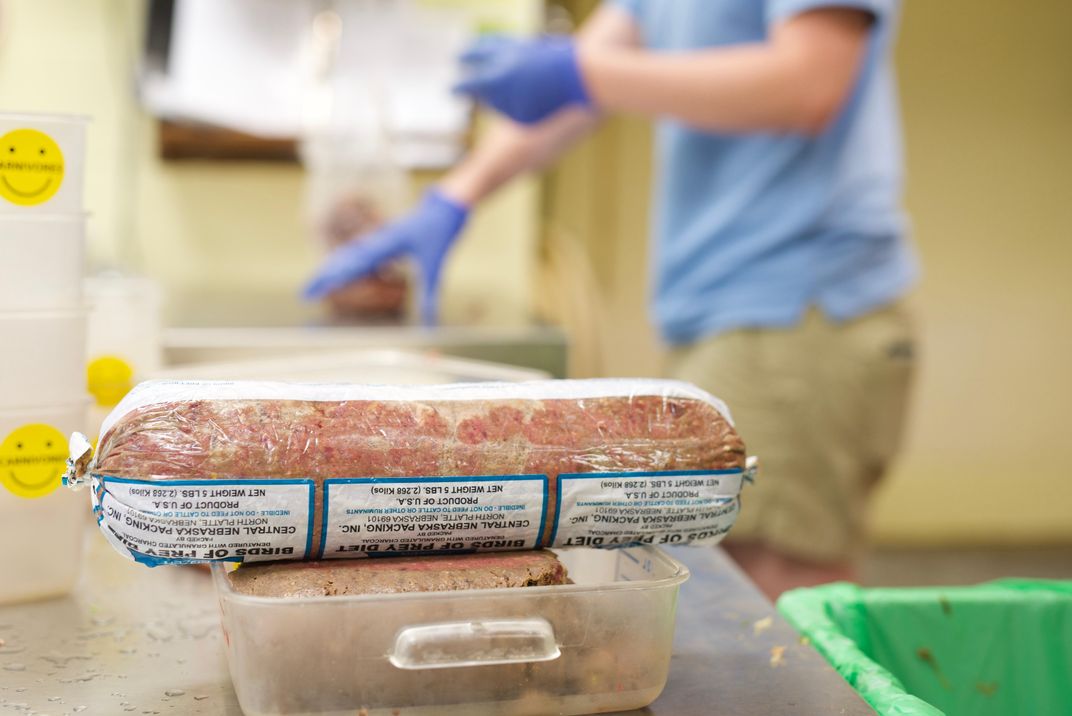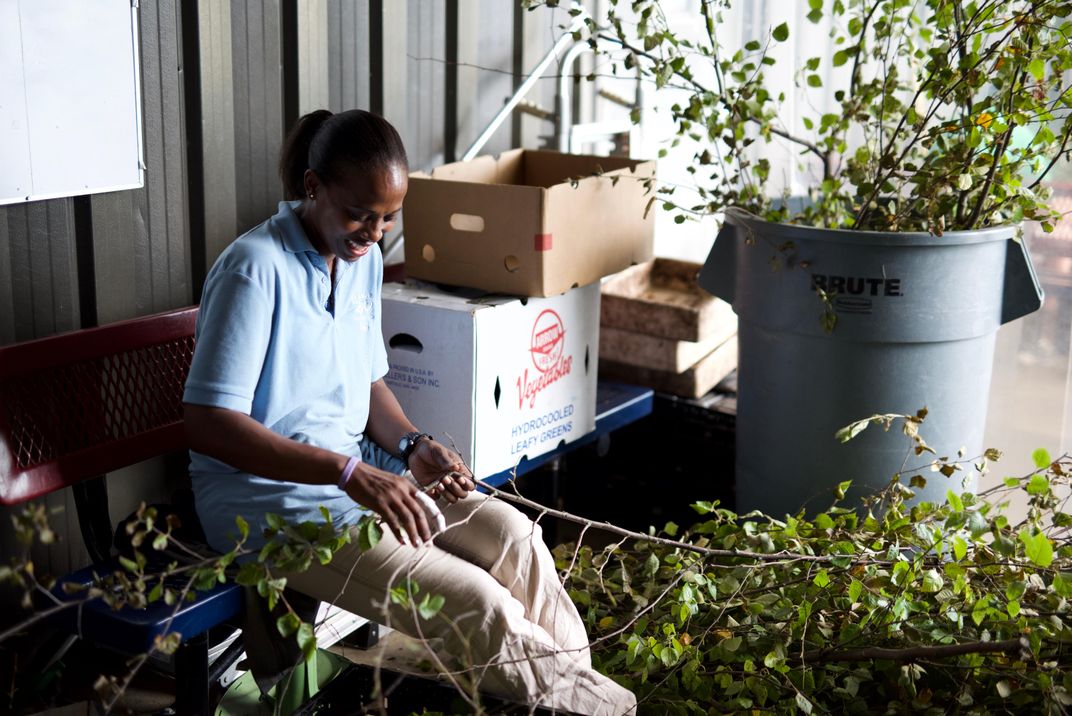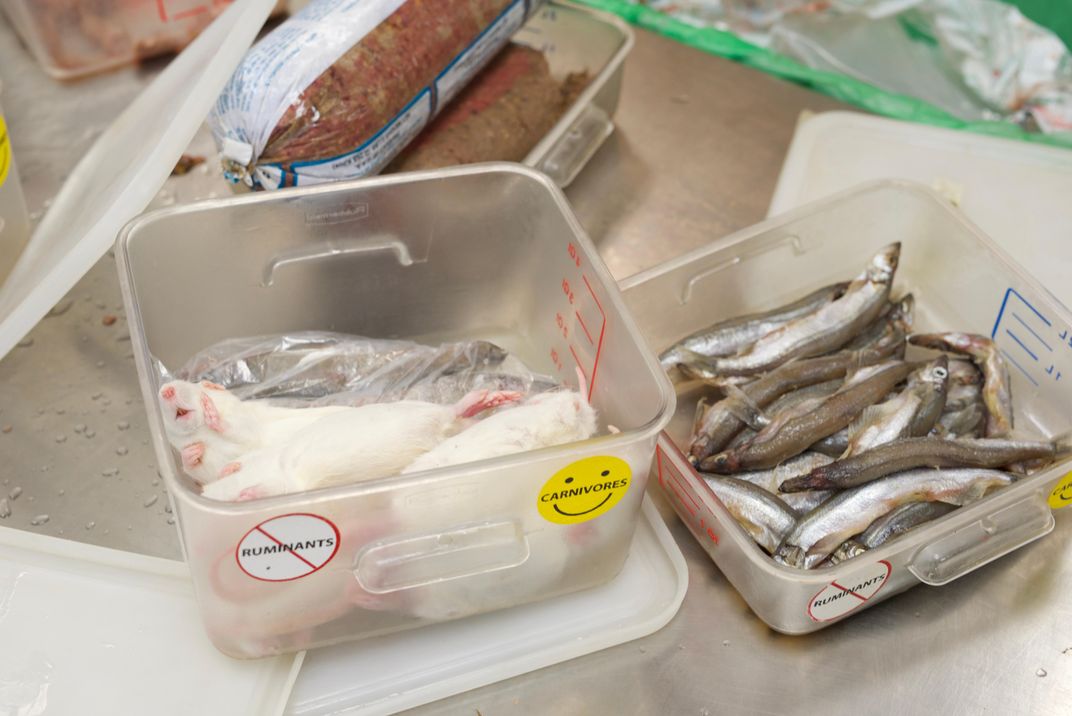When Disaster Strikes, the Zoo Must Go On
Zoo nutritionists have the Herculean task of feeding thousands of charges, come hurricane, tornado or terrorist attack
/https://tf-cmsv2-smithsonianmag-media.s3.amazonaws.com/filer/8a/64/8a64a13d-7e67-47b5-91d2-a57324fddbfb/dw3905.jpg)
When terrorists flew two airliners into the World Trade Center on September 11, 2001, a small team of animal nutritionists in Ohio jumped into action.
Every flight in the country had been grounded, which meant the Columbus Zoo and Aquarium’s weekly shipments of animal food would be delayed indefinitely. Fish for the penguins could be supplied from the zoo’s freezers, and leaves for the langurs (a genus of large Old World monkeys found throughout Southeast Asia) could be sourced locally. But what about the koalas?
Koalas, as you may know, subsist almost exclusively on a diet of eucalyptus shoots and leaves. They usually munch around 200 to 500 grams of the stuff every day, thanks to digestive systems that are specially adapted to digest the plant's usually inedible toxins. But eucalyptus is a tropical plant, and there was certainly none growing in Ohio in September. Usually, the zoo flew in its weekly shipment from Arizona.
With no idea how long the nation’s shipping routes would be down (and knowing that the rest of the country had more important matters to attend to than koala nutrition) zookeepers decided to take matters into their own hands, recalls animal nutrition assistant Amanda Zolman. They called up all the animal facilities nearby that also had koalas, pitched in to rent a truck, and decided to take a road trip to the closest eucalyptus supplier they could find. That ended up being in Florida, nearly a thousand miles away.
The experience was not soon forgotten. “Now, I try to keep a month and a half supply of everything,” says Zolman. “Our goal is to not to have to scramble like that.” Since 9/11, the zoo has constructed two greenhouses that grow nothing but 18 different species of eucalyptus, in case of future eucalyptus-blocking disaster catastrophes.
This scenario only scratches the surface of the logistical challenges zoo nutritionists face in their efforts to keep their thousands of charges fed and healthy. From planning ahead for natural disasters like hurricanes and floods, to dealing with catastrophic manmade disruptions, to simply meeting the daily nutritional needs and individual preferences of highly specialized animals, feeding a zoo may well be one of the most difficult jobs on Earth.
And to meet these challenges, zookeepers have had to get more than a little creative.
The Columbus Zoo and Aquarium is home to some 800 species of mammal, bird, reptile, and fish—more than 10,000 hungry mouths in all. And many of those fish survive on fresh brine shrimp flown in from Florida each week.
If the brine shrimp supplier should be impacted in anyway—several years ago, a storm ripped off the facility’s roof—the zoo will switch over to an emergency stockpile of shrimp they keep in freezers. But the reserves can only last so long, which means high winds and flooding in Florida have a very real impact on the wellbeing of tropical fish in Ohio.
Similarly, when Hurricane Katrina ravaged New Orleans, it also shut down the zoo’s largest cricket supplier, a staple insect for myriad lizards, frogs, and birds. Toxic algal bloom season, which seems to be getting longer each year due to climate change, can turn the anchovy supply poisonous. And that means finding alternative foods for the penguins.
Disaster or no disaster, one of the premier problems of feeding a zoo is pickiness. Take the koalas, for example; in the wild, these selective eaters choose to nibble on different eucalyptus species at different times of the year, avoiding one plant when it’s flowering and favoring another when it’s putting out fresh shoots. The Columbus Zoo’s female, Wruwallin, is particularly hard to please, says Zolman, noting that she’ll only eat the most tender shoots from a bouquet, and only when they’re presented in large quantities.
That’s why zookeepers are careful to give the resident koalas a taste of the on-site disaster stash every now and again just to make sure they’re acclimatized to the local flavor. “The soil we’re growing it in is very different than the soil in Arizona,” says Zolman. “So in the event we need to go full throttle, we want to make sure it’s an item that they’re actually going to eat.”
Similarly, penguins will only deign to eat whole fish that are less than six inches in length and no more than an inch wide. And when the Columbus Zoo is expecting chicks, they’ll need to have two- to three-inch fingerlings on hand for when the little ones transition from their parents’ crop milk to hard food.
Kiwi birds eat mostly earthworms. The zoo goes through 36,000 of the buggers annually. And here's a fun fact: One adult kiwi eats about three miles' worth of worms in a year. Still, Zolman says the worms are far preferable to the diet the birds came in on: beef hearts manually cut into worm-like ribbons.
Another challenge is sheer volume, particularly for leaf eaters. Elephants, monkeys, moose, and countless other creatures depend on a steady, gargantuan supply of roughage, which Zolman calls “browse.” So much in fact that the zoo sends crews out into the Columbus suburbs in search of edible greenery. Willow is a fan-favorite, but apple, birch, elm, mulberry, pear, and maple trees also contribute to the haul.
“The current list includes over 35 trees, shrubs and vines and over 45 herbs, perennials and other plants,” says Ann Lokai-Owens, the zoo’s resident browse horticulturist. One plant species they avoid: Red maple, since it can be toxic to certain animals.
To facilitate this supply chain, the zoo has made partnerships with local arboretums, conservatories, municipalities, and local businesses in its quest for quality greens. In fact, the zoo gets much of its browse from a super-secret Honda test track outside of Columbus that’s surrounded by lush wetland vegetation. (Though everybody that enters the facility has to forfeit their smartphone and swear secrecy about any test models they may glimpse.)
It's when the browse-finding crews return to the zoo, though, that the real work begins. Because this is Ohio, and winter is coming, workers must pick hundreds of thousands of leaves off these branches and store them in the freezers so the animals have food to eat when it gets cold. In all, the zoo's leaf-eaters will consume between 23 and 50 tons of roughage over the course of each year. Special care is also taken to account for any medical conditions and species-specific dietary restrictions.
There are less likely considerations to take into account as well. For instance, Lokai-Owens says they only harvest apple branches when the trees are devoid of fruit or berries since these can contain harmful cyanide compounds. Linden trees have to be pruned when they have leaves on them, because picky elephants won’t touch them otherwise—even though they like leafless willows just fine.
The National Zoo in Washington supplements its volume with a similar grow-your-own approach to Ohio’s: “We’re maybe the only zoo in the country to grow all of our own hay,” says Mike Maslanka, senior nutritionist at the National Zoo. Similarly, all those ornamental bamboo stands around the zoo are more than looks. “If there’s bad weather or we can’t get off grounds for some reason, we can still harvest within the zoo,” says Maslanka. That’s good news, because pandas eat little else.
Of course, food is used for more than sustenance at the zoo. It’s also used as a training tool. This, too, plays a role in emergency preparedness: In the event of a natural disaster like a tornado disrupting daily operations (as opposed to the menu), the keepers need to be able to get all outdoor animals into their enclosures right quick. And how do you get a 700-pound grizzly to do what you want? Well, a little cherry pie filling goes a long way.
Like Pavlov and his dogs, each animal is trained to associate a sound with a reward. The first week, the bear might get a scoop of pie filling every time it hears an air horn. Then the next week, it hears the air horn everyday but receives just one scoop at random. Then it goes for a month without getting pie filling. Then two months. But in the back of the bear’s mind it remembers that maybe, just maybe there’s cherry pie filling waiting in its enclosure when it hears the horn. And usually, that’s enough.
For the polar bears, it’s orange sherbet. The sloth bears prefer watermelons. Zolman says she isn’t in love with the idea of giving the animals foods like pie filling. But in this case, she concedes, the ends justify the means.
She's even deployed the trick during an unlikely emergency: the time a Canadian goose flew a little too low through the polar bear enclosure. “One of the girls just jumped up and grabbed it,” she says. “One had the head and one had the body and, well, it ripped apart pretty quickly.”
Then, as if on cue, one of the bears walked up onto center stage of the enclosure, a place known as Pride Rock after the promontory in The Lion King, and just stood there with the goose’s head in its mouth for all the world to see. “That was a fantastic time to try out emergency recall,” Zolman laughs.
It also goes to show that, even if every animal in the zoo has its own thoroughly researched and meticulously monitored diet, sometimes nature refuses to be micromanaged.



